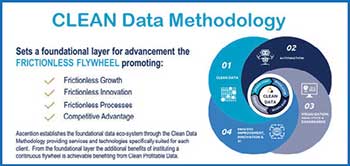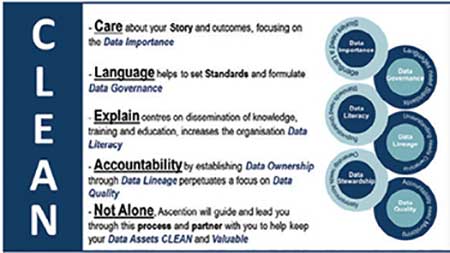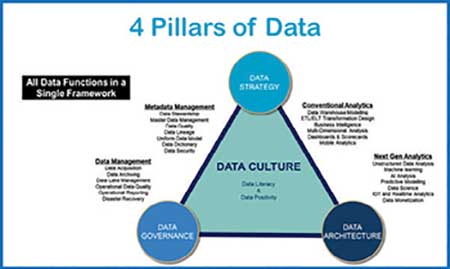THANK YOU FOR SUBSCRIBING

Ascention: Enhancing Profitability through CLEAN Data

 W. Daniel Cox III, Founder & CEO
W. Daniel Cox III, Founder & CEOAlongside the classification and refinement of the obtained data, businesses need to pay close attention to the timely delivery of information sets to the relevant decision-makers without necessarily compromising quality. As Dan mentions, C-suite executives have very little to no use of clean data if it isn’t made available at the right time. Collectively, factors such as accuracy and timely delivery of data are the pathways to achieve relevant, actionable insights, which align an organisation toward success.
A typical example of proffering such a customer experience is the modus operandi of banking institutions (similar to government entities), most of which are highly bureaucratic in nature. These organizations cannot simply bolt-on new technologies to provide next generation products and services to their consumer base as the institutions will continue to be plagued by problems from existing systems and traditional processes. If they want to remain relevant and provide amazing experiences for their customers then they must choose to develop solutions from the ground up with a focus on the data layer and its impact to operations, development and market. With the foundational data architecture laid, then frictionless low code/no code applications can be utilised to delivery market speed products and services. “Over the past few years, organizations have been focusing on big data and trying to execute on the term data-driven. In actuality, we have found that there is very little data of real value to truly help executives with their decision making. We must focus on what data is important to support the outcomes and goals of the decision maker and feed them information that that is relevant, timely and fit for purpose,” explains Dan.

The accuracy and availability of data makes or breaks the engagement between a service provider and its customers. In addition, adhering to compliance and regulatory requirement remains one of the primary prerequisites for these institutions. Focusing on the small data, businesses have begun breaking up large data sets, unstructured or structured, into their base attributes to improve the quality of the whole information set. A record or transaction is made up of several recurring small data attributes. If you have high quality master and reference data then when a transaction is created from these centrally managed core critical data points then those records naturally have a higher degree of quality, usability and value. Ascention positions itself as the market leaders in CLEAN Data which enables clients to convert unusable data into actional operational information and insightful analytics, which results in greater profitability nurtured through credible client engagements.
Turning Data Into Profit
“CLEAN Data doesn’t mean 100% perfect data, but rather it needs to be put in context of it’s usage and purpose for being. The context or focused outcomes drive understanding of what is important and consequently what data is important, that importance then provides the level of governance of needed for that data, which in turn promotes the quality necessary,” explains Dan. “If speed to decision is the higher priority, then it might be fine to have less accuracy; say a trending graph comparison of two marketing campaigns; as opposed to say a financial audit where accuracy would be paramount.”
CLEAN DATA DOESN’T MEAN 100% PERFECT DATA, BUT RATHER IT NEEDS TO BE PUT IN CONTEXT OF IT’S USAGE AND PURPOSE FOR BEING
The company utilises ‘CLEAN’ as an acronym to achieve business-critical outcomes in any collaborative effort.
The C in CLEAN stands for ‘Care’ – a quality that highlights Ascention’s talent to achieve definitive outcomes.
L relates to establishing the suitable language, communication standards and data governance attributes required.
Ascention’s also ensures that clients have ‘Educational’ program employed to understand, know and be able to utilise data effectively (Correlating to the E in CLEAN).
Likewise, ‘Accountability’ (with the alphabet A) is yet another element crafted to achieve the desired business objectives for clients; Ascention ensures ownership of data, lineage of data by focusing on the quality of the information aggregated.
Finally, the N in CLEAN is all about guaranteeing that ‘no organization is left alone’ in their data-driven journeys.
“It can be a daunting challenge for businesses to do everything that we do on their own. Most of these initiatives require a very high level of technical expertise that businesses may or may not possess. We ensure that organizations are not left behind in this expedition,” adds Dan.

The Four Pillars of Data MaturityThe aforementioned requirements are encapsulated into four business-critical avenues, which collectively empower data and technical professionals to increase value-add services into efficiencies, opportunities revealed and critical actionable insights for greater profitability. Ascention gauges each client’s data journey through readiness assessments within each of these categories, enabling them to understand areas for increased opportunities to mature.
Data Strategy, which constitutes the first pillar of data maturity, enables businesses to ensure that their information is utilised in the most appropriate manner possible.
Flowing from strategy, Data Architecture forms the second column, which ties into the representation of data schematics, workflows and streams through operational and analytical systems.

Underpinning strategy and architecture, Data Governance is the third and equally important leg of Ascention’s data maturity model, providing a bird’s eye view of policies and detailed pragmatic application of those policies into everyday data generation, transportation, rest and usage.
“Dirty Data Leads To Regulatory Breaches, Delayed Decisions And Sub-Optimal Strategiesw”
The last and fourth pillar that bolsters data maturity is Data Culture – a collective effort to foster information literacy and positivity, wherein C-suite executives are armed with the best-in-class programs to address any enterprise requirement. The four pillars essentially serve as guide rails to businesses, offering them a sense of direction as they pursue their business objectives. The merits of such business-critical capabilities can be observed through a recent engagement between Ascention and the Northern Territory Government, Australia. The Northern Territory is an enormous land area with a very low population of people, roughly around 290,000, and is comprised of large groups of Aboriginal and Native Australian habitants, which presents a unique set of problems to the governing authorities. Many of the Aboriginal people have at least two aliases for differing seasons of a year. “An example that illustrates the problem,” begins Dan. “I might use my name for the dry season, Dan Cox, but could use something like Sam Reynolds as my name for the wet season. As one can observe, there are no correlations to those names, and the use case that we were trying to solve for had an individual with 16 different aliases just as unique.” Adding to this predicament is the fact that a large percentage of the population tend to migratory and many do not have birth certificates or even know their specific birth dates because they are often born in the bush or on cattle stations or in communities without health facilities. As a result, identifying individuals is nearly an impossible task for civil service organisations. When individuals are provided services such as benefits, welfare, emergency responses or hospitalisation, the service provider may be unable to identify who the individual is, what their health records are and the kind of medication they could administer.
Ascention collaborating with the Northern Territory Government, had a herculean task on their hands, associating individuals with a wide assortment of aliases across several agencies and operational systems; from the Attorney General to Corrections, Police, Transportation and other departments. Ascention had to ensure that each of these departments was integrated with a master data sets that could verify the same individuals across different channels of interaction while abiding by the relevant legislation and segregation of appropriate access and visibility of personal data. Taking the challenge head-on, Ascention successfully created a ‘Golden Group’ for each individual, such that any entity providing civil services could not only understand who the person is but also provide them with the most appropriate service consistently.
Ascention, has time and again commemorated numerous such collaborations with clients, enhancing the quality of data and offering clients the potential to uncover invaluable sets of information that help them achieving definitive objectives. These collaborations continue to validate Ascention’s capabilities to transform dirty data to indispensable assets that are put to use creating profit.

I agree We use cookies on this website to enhance your user experience. By clicking any link on this page you are giving your consent for us to set cookies. More info













